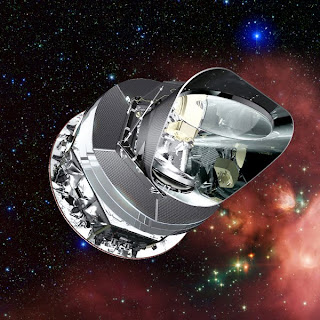 The Planck space telescope has begun to collect light left over from the Big Bang explosion that created our universe. The mission, which is led by the European Space Agency with important participation from NASA, will help answer the most fundamental of questions: How did space itself pop into existence and expand to become the universe we live in today? The answer is hidden in ancient light, called the cosmic microwave background, which has traveled more than 13 billion years to reach us. Planck will measure tiny variations in this light with the best precision to date.
The Planck space telescope has begun to collect light left over from the Big Bang explosion that created our universe. The mission, which is led by the European Space Agency with important participation from NASA, will help answer the most fundamental of questions: How did space itself pop into existence and expand to become the universe we live in today? The answer is hidden in ancient light, called the cosmic microwave background, which has traveled more than 13 billion years to reach us. Planck will measure tiny variations in this light with the best precision to date.The mission officially started collecting science data today, Aug. 13, as part of a test period. If all goes as planned, these observations will be the first of 15 or more months of data gathered from two full-sky scans. Science results are expected in about three years.
Read about NASA and JPL's role in the mission at http://www.nasa.gov/mission_pages/planck/overview.html .
More information about the mission is also online at http://www.esa.int/SPECIALS/Planck/index.html .
Wednesday, August 19, 2009
// //
0
comments
//
0 comments to "Planck Sees Light Billions of Years Old"
Popular Posts
-
Even though there are many advancement in technology, keeping foods fresher in space for a long period has been impossible. Research has b...
-
NASA is providing up to $20 million over the next five years to support a national program to inspire student interest in science, technolo...
-
NASA technologists will get a opportunity next summer time to experience the good old days when Organization technical engineers would conn...
-
Though the sun's brightness was once thought to be constant, NASA has launched a series of satellite instruments that have helpe...
-
X-24B Precision Landings Proved That Shuttle Could Land Unpowered NASA research pilot John Manke worked through his prelaunch checklist wh...
-
The mars rock touches the NASA curiosity this time it touches the more different from before Tasks. The mars rock is looks like some odd...
-
Images from NASA's Wide-field Infrared Survey Explorer (WISE) reveal an old star in the throes of a fiery outburst, spraying the cosm...
-
Leaner, greener flying machines for the year 2025 are on the drawing boards of three industry teams under contract to the NASA Aeronautics ...
-
The argument that the moon is a dry, desolate place no longer holds water. Secrets the moon has been holding, for perhaps billions of years,...












